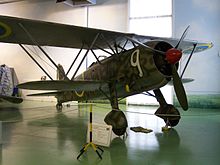Biplane (airplane)



As a biplane be planes having two superposed wings , respectively.
description
The main advantage compared to a monoplane is that the two wings are braced together (with stems to absorb compressive and tensile forces) and can be braced (with - often profiled - wires to absorb tensile forces) and thus form a structural unit which, with the same Weight is stronger than a cantilevered single wing.
The greater stability also allows the use of thinner wing profiles , which reduces air resistance. However, this advantage is negated by the mutual influence of the air flow of both individual wings, so that individual wings are usually superior in aerodynamics . Struts and bracing also create additional air resistance, so that high-performance aircraft have been designed entirely as monoplane since the 1930s.
With the same wing area and depth, a biplane only needs half the wingspan of a monoplane, which primarily benefits the rolling maneuverability. This is because the wing mass is closer to the center of gravity due to the smaller wingspan, which gives the aircraft a lower moment of inertia . The smaller span is also an advantage in handling the aircraft on the ground and in its accommodation.
history
The first successful double-decker designs were made in 1895 by Otto Lilienthal . The Wright brothers' first successful powered aircraft and many subsequent designs were also biplanes. In the First World War , in particular , aircraft were also built with three (or even more) wings one above the other, which basically had the same advantages and disadvantages as double-deckers.
drive
With a few exceptions such as the PZL M-15 Belphegor ( turbojet drive ) and the Antonow An-3 ( turbo- prop drive ), double-deckers are powered by piston engines.
speed
The fastest biplanes can be found [today?] At the National Championship Air Races . Biplanes of the types Pitts Special , Starduster, Knight Twister, Mong and Smith Minplane reach speeds of up to 370 km / h. The fastest biplane fighters of the Second World War were the Soviet I-153 with 444 and the British Gloster Gladiator with 414 km / h. Contemporary single-deckers were faster, which meant that double-deckers were pushed out of this role despite their comparatively greater maneuverability.
One and a half decker

The one-and-a-half-decker is a special type of double-decker. ( English sesquiplane ) This term is applied to:
- a biplane with a lower wing that has a significantly smaller wingspan than the upper wing,
- a double-decker, the upper wing of which has two spars, but the lower wing of which is single-spar,
- a biplane, the lower wing of which has a significantly smaller wing depth than the upper wing or
- a double-decker whose upper wing has a significantly smaller span than the lower wing (example: Fiat CR.1 ).
Features 2 and 3 often appear together. The Stinson Model U passenger aircraft was given the design of the lower wings shortened to improve aerodynamics compared to the previous model. Another reason for the construction of the one and a half-decker of types 1 to 3 was probably the significantly improved view downwards.
Trivia
The largest single-engine biplane is the Antonov An-2 .
literature
- Heinz AF Schmidt: Lexicon aviation . 2nd Edition. transpress - VEB Publishing House for Transport, Berlin 1972, p. 106 .
Web links
Individual evidence
- ^ Heinz AF Schmidt: Lexikon der Luftfahrt , Motorbuch Verlag, 1971, p. 32, ISBN 3-87943-202-3
